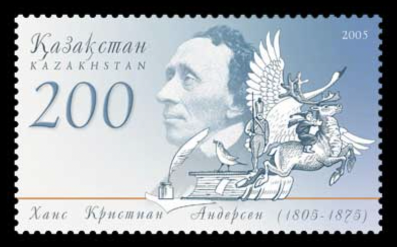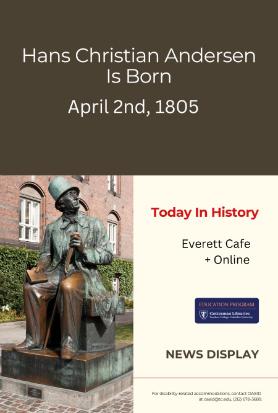Today In History: Remembering Hans Christian Andersen

He saw below him his own image, but he was no longer a clumsy dark grey bird, ugly and ungainly. He was himself a swan! It does not matter in the least having been born in a duckyard, if only you come out of a swan's egg;! He felt quite glad of all the misery and tribulation he had gone through; he was the better able to appreciate his good fortune now and all the beauty that greeted him. -- The Ugly Duckling, pp. 20-21 (1844)
Hans Christian Andersen was born on April 2nd, 1805 in a poor and rough part of Odense, Denmark, to Ane-Marie Anderstatter, wife of Hans Andersen. From his mother, a washerwoman, he inherited his height; from his father -- a shoemaker -- his dreams and creativity, including a puppet theater for which they crafted dolls, costumes, and plays. At the age of 11, he lost his father who suffered ill health after serving two years in Napoleon's army. Hans Christian Andersen's paternal grandmother visited often, recounting folktales and taking him to festivals and parades, while his grandfather, not of sound mind, wandered the woods and streets and behaved unconventionally.
An aspiring dancer, actor, and/or singer, Hans Christian left his small rural town for the capital city of Copenhagen at only fourteen years of age. He was unsuccessful in theater, but would become, over the following decades, a prolific and internationally famed writer of plays, travelogues, novels, poems, and literary fairy tales. Altogether Andersen wrote 36 plays; 6 travel books; 6 novels; hundreds of poems; 170 tales and stories; in addition to copious letters -- translated into numerous languages over the following centuries.
His success with fairy tales, included such works as The Princess and the Pea, Thumbelina (1835); The Emperor's New Clothes, The Little Mermaid (1837); The Nightingale, The Snow Queen, The Ugly Ducking (1844); The Fir Tree, The Red Shoes (1845); The Puppet-Show Man (1851); The Pen and the Inkwell (1860); What Father Does Is Always Right, The Ice Maiden (1861); Godfather's Picture Book (1868); Lucky Can Be Found in a Stick, A Question of Imagination, The Rags (1869). It was the genre of fairy tales that drew special interests and European court invitations -- leading to monuments in his name, among them: Hans Christian Andersen, by August V. Saabye, 1880 (King's Garden, Copenhagen); The Little Mermaid, an iconic waterside statue by Edvard Eriksen, 1913 (Langelinie, Denmark); and the life-sized bronze sculpture by Georg John Lober, 1956 (New York City's Central Park).
From being an unusual, lanky, and often ridiculed child, Hans Christian Andersen grew into one of the most beloved authors of all time. He used his artistic talents, including delightfully original paper cuttings, to escape his impoverished background and create his dream-come-true, not unlike a fairy tale. With magical and fantastical elements, folkloric characters, and both happy and tragic endings, Andersen's fairy tales, like his life's experiences, illuminate courage and perseverance over misery; hope over despair, and good over evil, among other moral teachings and values.
The following articles are drawn from Proquest Historical Newspapers, which informs and inspires classroom teaching and learning.
- Reed, H. L. (1895, Jan 27). Hans Christian Andersen; A Wonderful Danish Boy and His Puppet Theater -- The Story of His Life. The Atlanta Constitution (1881-1945)
- For Little Men and Little Women: Hans Christian Andersen. (1905, Apr 02). New - York Tribune (1900-1910)
- Moore, A. C. (1925, Mar 29). The Three Owls: Hans Christian Andersen's Birthday. The New York Herald, New York Tribune (1924-1926)
- Moritzen, J. M. (1925, Mar 29). Hans Christian Andersen's 120th Anniversary: City of Odense, His Birthplace, Makes His Boyhood Home the Andersen Museum. New York Times (1923-)
- Lyons, L. (1928, Dec 23). Old Fairy Tales Than Never Will Grow Old: Hans Christian Andersen's Stories Most in Demand, Even, By Modern Children -- and Grown Folks, Too. Daily Boston Globe (1928-1960)
- World Marks Birthday of Hans Christian Andersen. (1955, Apr 03). Los Angeles Times (1923-1995)
- Sass, Fred J. (1957, Apr 03). Hans Christian Andersen's Birthday Observed Here. New York Times (1923-)
- Graeber, L. (2005, Apr 01). Family Fare: A Fairy-Tale Birthday for a Very Old Friend. New York Times (1923-)
- Montgomery, D. (2005, Apr 02). The Ugly Duckling's Happily Ever After: Hans Christian Andersen's Wish for Lasting Fame Came True. The Washington Post (1974-)
- Ellis, S. (2005, May 15). Give Peas a Chance: The Adventures of Hans Christian Andersen's Five Peas in a Pod, Transplanted to Imperial China. New York Times (1923-)

Tips:
- Andersen, H. C. (Hans C. (2018). The Improvisatore : A Novel of Italy (F. Hugus, Tran.; 1st ed.). University of Minnesota Press. e-book.
- Also see Gottesman Libraries' children's books by Hans Christian Andersen.
- Brust, B. W. (1994). The Amazing Paper Cuttings of Hans Christian Andersen. Ticknor & Fields. Juvenile ; PT8119.9 .B78 1994.
- Hesse, K., & Blegvad, E. (2005). The Young Hans Christian Andersen (First edition.). Scholastic Press. Curriculum ; PT8119 .H46 2005.
- Tenger, H. (2016). The Fairy Tales and Stories of Hans Christian Andersen (H. L. Braekstad, Tran.; 1st ed.). Race Point Publishing. e-book.
- Varmer, H. (2005). Hans Christian Andersen : His Fairy Tale Life. Groundwood Books/House of Anasi Press. Juvenile ; PT8119 .V37 2005.
- Yolen, J., & Nolan, D. (2004). The Perfect Wizard : Hans Christian Andersen (First edition.). Dutton’s Children’s Books. Curriculum ; PT8119 .Y65 200.4
Images:
- Hans Christian Andersen Stamp of Kazakhstan, Courtesy of Wikimedia Commons.
- Statue of Hans Christian Andersen, Courtesy of Canva.
Need to keep current, look to the past, teach a topic? The Everett Cafe features daily postings of news from around the world, and also promotes awareness of historical events from an educational context. Be sure to check additional Cafe News postings on the library blog.

